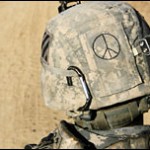(revised April, 2021)
If there is a single symbol that conjures up memories, and even to a great extent stands for our generation, it is the ‘peace symbol’, or peace symbol emoji as some now refer to it.
Do not confuse the peace symbol with the two fingered peace sign. They do have similar meanings. The most obvious difference is in usage. The peace sign is flashed rather impulsively. The peace symbol is drawn or painted as a more permanent display.
It is beginning to loose its popularity in the 2020s, but I have seen some new tattoos and jewelry.
The peace symbol emoji’s history and derivation is rather new to me. I will be it will be enlightening to you as well.
The peace symbol emoji first caught my attention in high school around 1963. The war in Vietnam was underway. Drawing the peace symbol on a notebook or a brown paper, book cover felt like a counter culture act. Likewise on T-Shirts and caps.
Then came all the creative art that incorporated in the peace symbol. Some rather plain other quite elaborate.
Many would be surprised that the country that gave us the Beatles also birthed the symbol that we put around our necks, drew on high school sidewalks, and sprayed on walls in the 1960s.
To political activists in the United States this peace symbol emoji beckoned for an end to the Vietnam war. It appeared on flags carried by antiwar protesters as they marched through America’s cities. To a much broader spectrum of we Baby Boomers, it conjured up a more emotional peace with ourselves that came from breaking from what we saw as the uptight generation of our progenitors.
To this day, the peace symbol emoji has an almost spiritual effect on me. Reminding me of transitions in my teen years.
To designer and WWII conscientious objector Gerald Holtom, who first drew the symbol it was a sign of objection to nuclear weapons, sort of a ‘ban the bomb’ icon. He designed it for once specific occasion: a 50 mile protest march from London’s Trafalgar Square to a weapons factory at Aldermaston. The march was organized by the Direct Action Committee Against Nuclear War (DAC) and the Campaign for Nuclear Disarmament (CND) joined in.
Holtom in fact decided to go for a much more personal approach, as he admitted to Brock, editor of Peace News, Hugh “I was in despair. Deep despair,” he wrote. “I drew myself: the representative of an individual in despair, with hands palm outstretched outwards and downwards in the manner of Goya’s peasant before the firing squad. I formalized the drawing into a line and put a circle round it. It was ridiculous at first and such a puny thing.”
A puny thing has become an internationally recognized symbol.
Peace Symbol Emoji Design
Like many symbols it is modification of existing images and filled with new meaning. Holtom rendered two navy semaphore codes




to line drawings and placed them over each other to form the symbol:


The codes N and D, in Holtom’s mind, stood for Nuclear Disarmament. His original drawing is housed in the Peace Museum, U.K. in Bradford, England.
60’s activists and flower children were not the only United States citizens to employ the peace symbol, but in Vietnam US troops who identified with them also dawn the symbol. Some of our troops in Baghdad brandish the symbol today.


Gerald Holtom died on September 18, 1985 at the age of 71, but the symbol he designed remains.
The peace symbol emoji is a protest. See our series of articles concerning protests of the 1960s and beyond, here.



